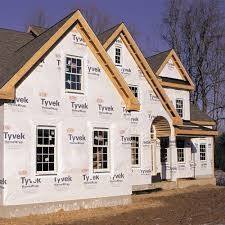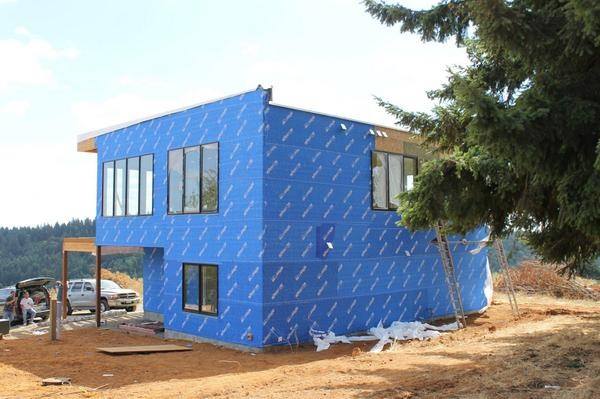Don’t Let The Weather Put a Damper On Your Investment
Whether you’re building a new home, adding on to your existing home, or just giving your home’s exterior a much-needed face-lift, one of the most overlooked yet important elements is the house wrap.
What is house wrap?
Your home’s exterior is constructed of layers of material. A typical home is made up of wood framed walls, exterior sheathing, and exterior cladding. Your finished exterior may consist of brick, stone, stucco, siding, or a combination of these. These exterior finishes may appear to be your primary defense against the elements but they are not.

In-between your walls sheathing and exterior cladding is your “House Wrap”, a material designed to prevent moisture (and in some cases air) from penetrating your walls, while at the same time allowing water vapour to escape. Traditionally, houses were wrapped in felt paper as the primary defense against the outside elements. Synthetic materials have since replaced these practices. Tyvek, for example, is a synthetic breathable membrane with millions of microscopic pores. Tyvek helps prevent water from penetrating your home’s exterior while still allowing water vapour to escape.
Tyvek has proven to be an excellent material, but only IF it is installed correctly. Tyvek is installed in a manner where mechanical fasteners are used to secure it in place, which of course puncture the membrane. All seams need to be overlapped and taped to prevent water from seeping in behind. If its not installed properly, as in many unfortunate cases it is not, it will not perform and moisture will end up trapped, creating the perfect habitat for mold and rot. If your project uses Tyvek (or similar), ensure it is installed by a reputable company who will install it correctly.
Another product available is VP100, manufactured by The Henry Co. This product is ideal for wood frame construction as well as many other smooth substrates. We have used it on a number of projects, including the personal residence of one of Macanta’s founding partners! It is a peel and stick system that allows installation without the use of fasteners (no holes!) and creates a 100% sealed barrier.

VP100 still requires the appropriate overlaps and correct installation of course, so insist on working with a reputable company. What VP100 does not require, however, is the taping of joints. This system eliminates air leakage while giving the added protection of water resistance and rain barrier without the added need of a rain screen. Another notable quality is that it enhances in-home comfort by eliminating drafts, which in turn reduces energy consumption. Some claims state a 23-50% decrease in energy consumption. These benefits do not come without cost; the initial investment for VP100 is higher than more traditional building wraps.
Regardless of which technology you choose for your project, ensure that your builder or renovator installs it correctly by working with a reputable builder or renovator.
Do you have questions about the various house wrap options for a project that you are considering? Give us a call today! 204-977-6604.

Leave a Comment
You must be logged in to post a comment.